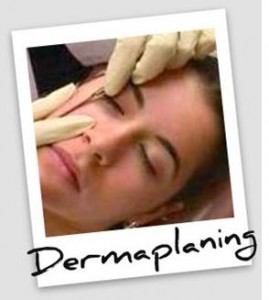What is DermaPlaning?
DermaPlaning is one of the most effective techniques used to exfoliate the outer skin layers using a blade instead of chemicals or lasers. DermaPlaning resurfaces the skin and removes unwanted facial  hair temporarily. And no, the hair will not return thicker or darker after this treatment! Hair can trap oil and dirt leading to other skin problems, so DermaPlaning is a great preventative treatment. When compared to alternative treatments, DermaPlaning has the advantage of NOT causing broken capillaries on facial skin! This treatment is painless, very safe and is usually performed every 4-6 weeks. DermaPlaning is inexpensive and does not include a lot of downtime (a little redness 24-48 hours afterwards) which is always good for women with hectic work schedules. It can be performed on any skin tone. After DermaPlaning, the skin is left feeling baby smooth and make-up is much easier to apply. DermaPlaning also helps topical treatments work more effectively since the skin is “fresh”. A lack of skin cell “build up” allows creams/serums to work more effectively as they can penetrate more easily. DermaPlaning is not a new technique and has been used for many years. It is a quick way to immediately revitalize the skin and remove unwanted facial hair.
hair temporarily. And no, the hair will not return thicker or darker after this treatment! Hair can trap oil and dirt leading to other skin problems, so DermaPlaning is a great preventative treatment. When compared to alternative treatments, DermaPlaning has the advantage of NOT causing broken capillaries on facial skin! This treatment is painless, very safe and is usually performed every 4-6 weeks. DermaPlaning is inexpensive and does not include a lot of downtime (a little redness 24-48 hours afterwards) which is always good for women with hectic work schedules. It can be performed on any skin tone. After DermaPlaning, the skin is left feeling baby smooth and make-up is much easier to apply. DermaPlaning also helps topical treatments work more effectively since the skin is “fresh”. A lack of skin cell “build up” allows creams/serums to work more effectively as they can penetrate more easily. DermaPlaning is not a new technique and has been used for many years. It is a quick way to immediately revitalize the skin and remove unwanted facial hair.
How is DermaPlaning Performed?
DermaPlaning is safely performed by using a sterile surgical blade. Don’t let the word blade overwhelm you, this is a very safe and effective skin rejuvenation treatment and can be compared to shaving. Your licensed aesthetician holds your skin as taut while stroking the blade against the skin at a 45 degree angle. This particular medical spa treatment is relatively quick and painless.
Will My Hair Grow Back Thicker?
This is a common misconception tied to Dermaplane name and is completely false. It is physiologically impossible for hair to grow back thicker. We have two different types of hair on our bodies Vellous hair and Terminal hair. Vellous hair which is most often located on our face and appears to be almost translucent or blonde. Where Terminal hair is much thicker and grows mainly on our under arms, pubic area, and eye brows. It can also be found on men’s legs and lower facial area.
How often is this procedure performed?
The normal skin growth cycle is around 30 days and since dermablading removes about 2-3 weeks-worth of dead skin cells, it’s best to wait about 3-4 weeks between treatments.
Can blading or DermaPlaning be performed in the same visit as a chemical peel?
A chemical peel done immediately after DermaPlaning is an excellent way to make sure that the peel penetrates deeper and more evenly. Lactic acid peels will hydrate and further exfoliate dry and normal skin while a glycolic acid peel is strong enough to combine with DermaPlaning for oily skin.
What skin types/conditions can be treated?
The only skin that probably shouldn’t be treated with DermaPlaning is acne-prone skin. The oil from the sebaceous glands needs to travel up and connect with the vellous hair in order for it to be excreted. If the hair is removed and the oil builds up, the glands are obstructed and cause more breakouts.
